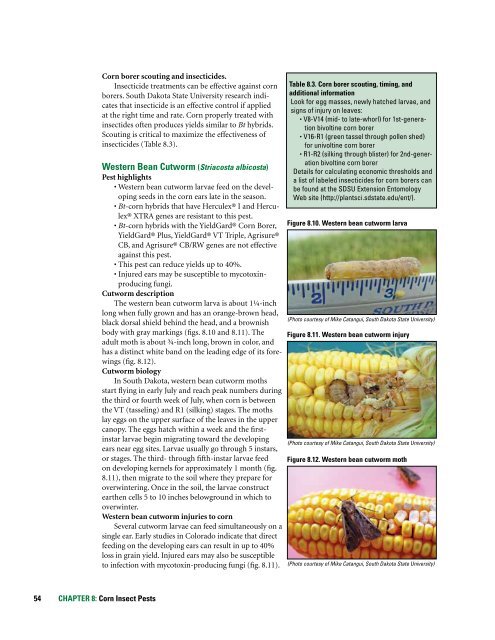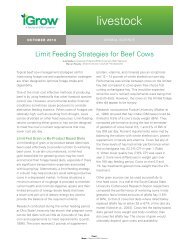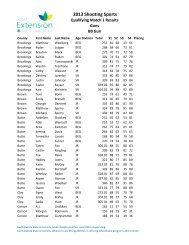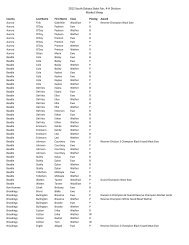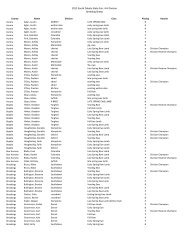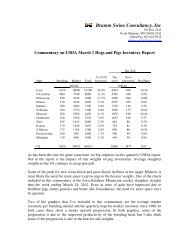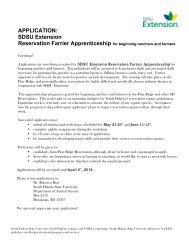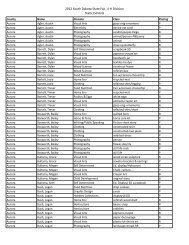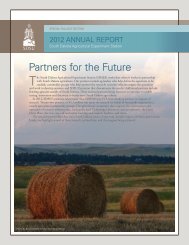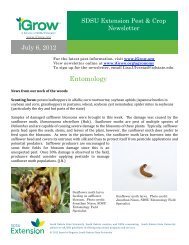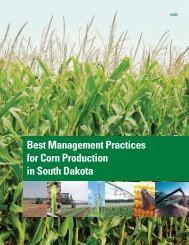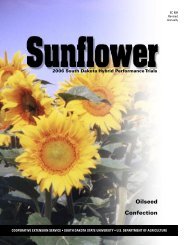Best Management Practices for Corn Production in South Dakota
Best Management Practices for Corn Production in South Dakota
Best Management Practices for Corn Production in South Dakota
Create successful ePaper yourself
Turn your PDF publications into a flip-book with our unique Google optimized e-Paper software.
54<br />
<strong>Corn</strong> borer scout<strong>in</strong>g and <strong>in</strong>secticides.<br />
Insecticide treatments can be effective aga<strong>in</strong>st corn<br />
borers. <strong>South</strong> <strong>Dakota</strong> State University research <strong>in</strong>dicates<br />
that <strong>in</strong>secticide is an effective control if applied<br />
at the right time and rate. <strong>Corn</strong> properly treated with<br />
<strong>in</strong>sectides often produces yields similar to Bt hybrids.<br />
Scout<strong>in</strong>g is critical to maximize the effectiveness of<br />
<strong>in</strong>secticides (Table 8.3).<br />
Western Bean Cutworm (Striacosta albicosta)<br />
Pest highlights<br />
op<strong>in</strong>g<br />
seeds <strong>in</strong> the corn ears late <strong>in</strong> the season.<br />
Bt-corn hybrids that have Herculex® I and Herculex®<br />
XTRA genes are resistant to this pest.<br />
Bt-corn hybrids with the YieldGard® <strong>Corn</strong> Borer,<br />
YieldGard® Plus, YieldGard® VT Triple, Agrisure®<br />
CB, and Agrisure® CB/RW genes are not effective<br />
aga<strong>in</strong>st this pest.<br />
<br />
<br />
produc<strong>in</strong>g fungi.<br />
Cutworm description<br />
The western bean cutworm larva is about 1¼-<strong>in</strong>ch<br />
long when fully grown and has an orange-brown head,<br />
black dorsal shield beh<strong>in</strong>d the head, and a brownish<br />
body with gray mark<strong>in</strong>gs (figs. 8.10 and 8.11). The<br />
adult moth is about ¾-<strong>in</strong>ch long, brown <strong>in</strong> color, and<br />
has a dist<strong>in</strong>ct white band on the lead<strong>in</strong>g edge of its <strong>for</strong>ew<strong>in</strong>gs<br />
(fig. 8.12).<br />
Cutworm biology<br />
In <strong>South</strong> <strong>Dakota</strong>, western bean cutworm moths<br />
start fly<strong>in</strong>g <strong>in</strong> early July and reach peak numbers dur<strong>in</strong>g<br />
the third or fourth week of July, when corn is between<br />
the VT (tassel<strong>in</strong>g) and R1 (silk<strong>in</strong>g) stages. The moths<br />
lay eggs on the upper surface of the leaves <strong>in</strong> the upper<br />
canopy. The eggs hatch with<strong>in</strong> a week and the first<strong>in</strong>star<br />
larvae beg<strong>in</strong> migrat<strong>in</strong>g toward the develop<strong>in</strong>g<br />
ears near egg sites. Larvae usually go through 5 <strong>in</strong>stars,<br />
or stages. The third- through fifth-<strong>in</strong>star larvae feed<br />
on develop<strong>in</strong>g kernels <strong>for</strong> approximately 1 month (fig.<br />
8.11), then migrate to the soil where they prepare <strong>for</strong><br />
overw<strong>in</strong>ter<strong>in</strong>g. Once <strong>in</strong> the soil, the larvae construct<br />
earthen cells 5 to 10 <strong>in</strong>ches belowground <strong>in</strong> which to<br />
overw<strong>in</strong>ter.<br />
Western bean cutworm <strong>in</strong>juries to corn<br />
Several cutworm larvae can feed simultaneously on a<br />
s<strong>in</strong>gle ear. Early studies <strong>in</strong> Colorado <strong>in</strong>dicate that direct<br />
feed<strong>in</strong>g on the develop<strong>in</strong>g ears can result <strong>in</strong> up to 40%<br />
loss <strong>in</strong> gra<strong>in</strong> yield. Injured ears may also be susceptible<br />
to <strong>in</strong>fection with mycotox<strong>in</strong>-produc<strong>in</strong>g fungi (fig. 8.11).<br />
CHAPTER 8: <strong>Corn</strong> Insect Pests<br />
Table 8.3. <strong>Corn</strong> borer scout<strong>in</strong>g, tim<strong>in</strong>g, and<br />
additional <strong>in</strong><strong>for</strong>mation<br />
Look <strong>for</strong> egg masses, newly hatched larvae, and<br />
signs of <strong>in</strong>jury on leaves:<br />
V8-V14 (mid- to late-whorl) <strong>for</strong> 1st-generation<br />
bivolt<strong>in</strong>e corn borer<br />
V16-R1 (green tassel through pollen shed)<br />
<strong>for</strong> univolt<strong>in</strong>e corn borer<br />
R1-R2 (silk<strong>in</strong>g through blister) <strong>for</strong> 2nd-generation<br />
bivolt<strong>in</strong>e corn borer<br />
Details <strong>for</strong> calculat<strong>in</strong>g economic thresholds and<br />
a list of labeled <strong>in</strong>secticides <strong>for</strong> corn borers can<br />
be found at the SDSU Extension Entomology<br />
Web site (http://plantsci.sdstate.edu/ent/).<br />
Figure 8.10. Western bean cutworm larva<br />
(Photo courtesy of Mike Catangui, <strong>South</strong> <strong>Dakota</strong> State University)<br />
Figure 8.11. Western bean cutworm <strong>in</strong>jury<br />
(Photo courtesy of Mike Catangui, <strong>South</strong> <strong>Dakota</strong> State University)<br />
Figure 8.12. Western bean cutworm moth<br />
(Photo courtesy of Mike Catangui, <strong>South</strong> <strong>Dakota</strong> State University)


